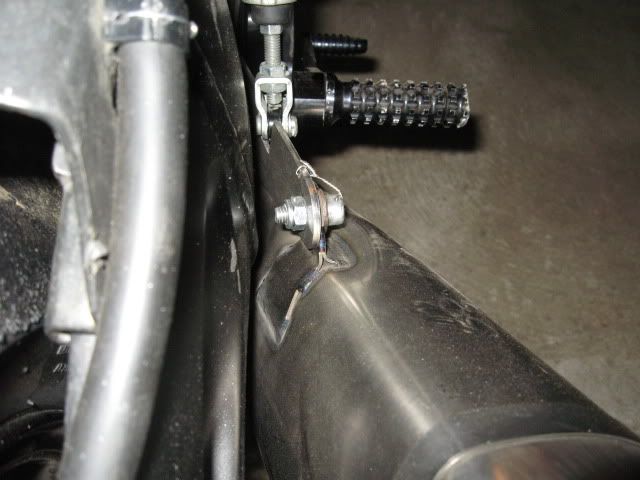0




Here is some pics for those who Like my self may need some Constructive criticism or Hope fully a Thread that helps with the process of Safety Wire a bike...
and Please keep the BS out of the thread and on topic....if possibleand pls add pics comments on what to do and if there is some thing missing>>>
1.
2.
3.
4.
5.
6.
7.
8.
9.
10.
11.
12.
13.
14.
15.
16.
17.
18.
19.
20.
21.
22.
One of my Questions is Nuts like this one on the back has the Plastic in it and won't Back off>>>>>Is that going to Fly with Tech?????
23.


Last edited by Pigman; 04-13-10 at 06:45 AM.
LRRS EX 66
BostonMoto | Yoshimura | GoPro | K/N | Amsoil | Computrack | Vortex Sprockets |
EBC | Dunlop | Woodcraft | ArmourBodies | Fuel Clothing | Progrip | FmF Racing|
factoryeffex
You should be ok not safetywiring vibra-nuts. Also, a couple of your safety wire jobs aren't set so the wire is 'pulling' the nut/bolt tight, those won't fly.
Pics 5, 9 , 15 and 20 - the safety wire really isn't doing anything in those pics.


ahhhh so tight between no slack OK..and the vibra NUTS are good thks APP this...back to fix these


LRRS EX 66
BostonMoto | Yoshimura | GoPro | K/N | Amsoil | Computrack | Vortex Sprockets |
EBC | Dunlop | Woodcraft | ArmourBodies | Fuel Clothing | Progrip | FmF Racing|
factoryeffex
For example the safety wire on the axle pinch bolts should make a backwards 's' when you're looking at it. If that makes any sense. The wire should wrap around the head of the bolt clockwise pulling it tight.
A little sloppy but this is the idea:



Last edited by DBB; 04-13-10 at 06:55 AM.
Q did a write up a little while ago on safety wiring for our blog... not sure if it'll be helpful to you but you can check it out here. The CBR600RR I picked up also makes extensive use of D-clips which apparently are available at Home Depot... a handful of those (for axles, caliper bolts, pinch bolts, etc.) and some safety wire with plastic tubing to protect it can go a long way toward making it a) look snappy, and b) be nice 'n easy to remove and re-wire for quick wheel changes. Here's some pics the guy who I bought my bike from had posted... shows quite a level of detail / attention paid in the prep work!



why'd you safety wire your gauges on? you're better off with the fancy poklastic stuff coming off in a roll than staying tethered to a rolling bike.
basically kurlon is right though, they need to be pulling the bolt(s) in a clockwise direction.
I do disagree that loctite or lock-nuts are a subsitute. You should be safety wiring the bolt/nut to itself.


Cool APP IT>>>>>


LRRS EX 66
BostonMoto | Yoshimura | GoPro | K/N | Amsoil | Computrack | Vortex Sprockets |
EBC | Dunlop | Woodcraft | ArmourBodies | Fuel Clothing | Progrip | FmF Racing|
factoryeffex
Pretty much what everyone has said, the bolt should be pulled tight by the wire. If you have any questions about a certain bolt post a pic and I could MS paint a line on it.


-Alex
I can resist everything but Pete's mom.
the wire should run through the exhaust springs also. its not so they hold the pipes together. its to keep the spring with the bike and not leave it on track if it breaks.


LRRS Am #331
Graphic Tailor / Woodcraft / Armour Bodies / Suomy / Cycle Performance Autobody / Shorai / ChickenHawk Racing


Based on that, all radiator caps must be wired.Originally Posted by 2010 LRRS Rulebook


OK, I don't race but out of interest have a question.
If the safety wire is tethered to a fixed part of the bike, as I see it, in all of the photos, the most a bolt could move is about 1/2 turn. Given most nuts and bolts engage over aprox 8 to 10 threads (metric pitch) even if the bolts loosen by 1/2 turn, nothing would actually fall off the bike. That said, why is it so critical to have them anchoring the bolt tight?
To clarify, I am talking about bolt on parts, exhaust, calipers etc. not hoses or oil lines which obviously need to be tight.


If they loosen they are more apt to shear.


-Alex
I can resist everything but Pete's mom.
Try it for yourself, wire loosely, then see how much resistance the wire offers to removing the fastener. Basically, once that wire is 'loose' it won't stop a fastener from coming completely off. Being in 'tension' is what allows it to work.


Well, I have tried it and to be honest, if it cannot rotate more than 1/2 turn, it cannot come off. (unless the wire snaps) Point taken about shear, especially on calipers.
I am a mechanical engineer and deal with critical materials in hazardous enviroments, not trying to be an ass, just looking at it logically from an engineering standpoint


I could see a situation where if it was too loose it and the bolt started to back out then the wire could just start turning/twisting. the more it turns it could just break the wire. much like it breaks if you twist it too much with the pliers.


LRRS Am #331
Graphic Tailor / Woodcraft / Armour Bodies / Suomy / Cycle Performance Autobody / Shorai / ChickenHawk Racing


"I'd rather ride a slow bike fast than a fast bike slow"
Bikes: Ducati: 748 (Track) Honda: RC31 (Race/street)/ CRF 110 Mini Moto/ Hawk Endurance Racer Kawasaki: ZXR1200R
BOMO Instructor
EX# X